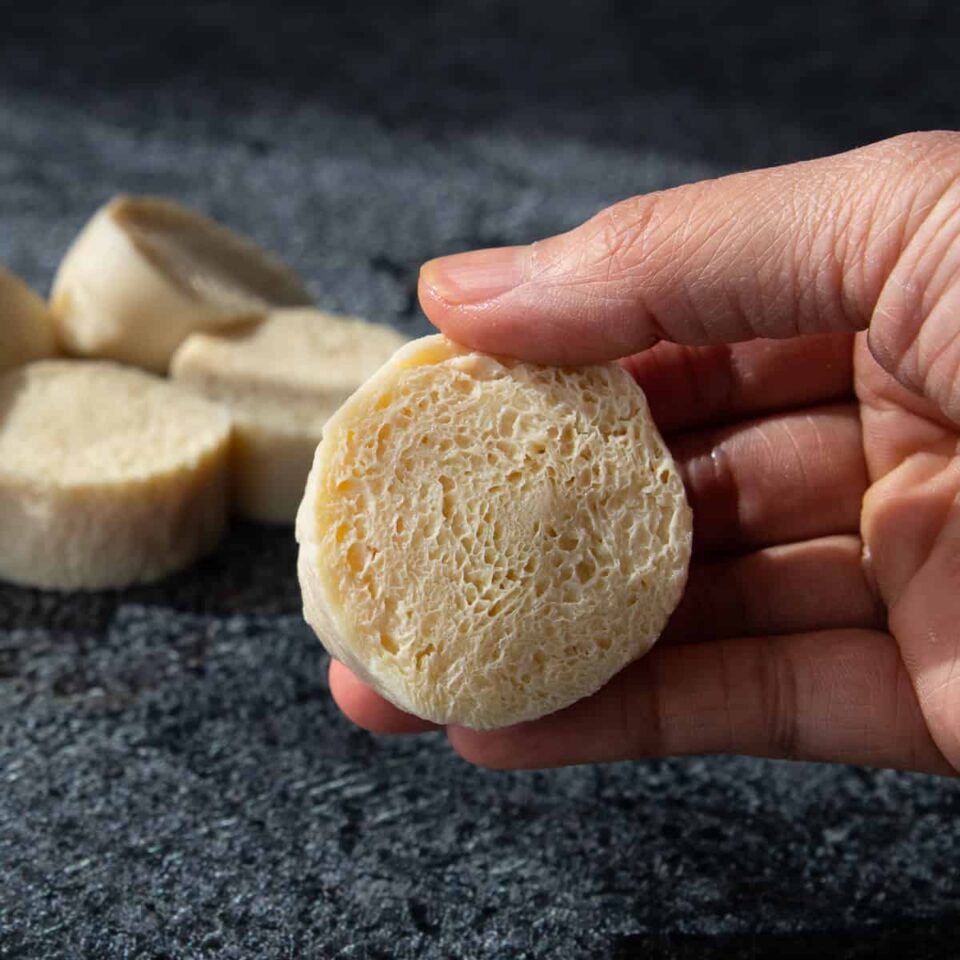I told my husband the other day to put away the groceries and freeze all the protein…I mean all the meat. The next thing I know, I opened the freezer and there was my…completely bizarre looking tube of soft tofu.

After taking a deep breath and reminding myself that tofu is technically a protein, I decided to cook frozen tofu and then post it on Instagram AND YT shorts where it went viral on BOTH platforms. To my surprise, people are very interested in the concept of freezing tofu! And it’s absolutely a fascinating process, so I want to explore freezing tofu further.
So for our exploration I froze 2 types of tofu – silken and firm – so we could see the two extremes; and you’ll also see WHY you might want to freeze tofu on purpose, what happens to them when you do, and how to use the results in your cooking.
Jump to:
Watch the video
If you want to get all the great pictures (and frozen tofu is pretty awesome), everything I cover in this post is also covered in this video. Enjoy!
What types of tofu can you freeze?
You can freeze any type of tofu; anything from silky all the way up to extra firm, depending on the texture you want in the end. Soft tofu will stay soft and firm tofu will stay firm, but everything will be a little firmer and less brittle than it originally was.
How to freeze tofu


There is ZERO trick to freezing tofu and don’t believe anyone who tries to make you do any kind of “prep work”. The simplest way is best: stick them in the freezer in the package, just like my husband did. Once frozen, it will look completely wrong; the color will become dark yellow and translucent as shown in the photo above.
Tofu does not need to be frozen for any particular length of time; you can thaw it as soon as it’s completely frozen or leave it there until you want to use it. Leave it to defrost in its packaging in the refrigerator for a few days or in a bowl of water at room temperature (it will take 3-4 hours), although obviously the times will depend on the size of the tofu. If you thaw it in water, keep changing the water once it becomes frozen so it defrosts faster.
*Once defrosted, tofu will last at least a week in the refrigerator (unless it is almost expired) so you can defrost it well in advance.
How NOT to freeze tofu
Some people will tell you to cut the tofu into pieces, dry them with a towel, and then freeze them on a tray as individual pieces. If you just want to store tofu long term, that’s fine, but if you want to reap the benefits of processing frozen tofu, that’s actually the OPPOSITE of what you want to do!
Yes, freezing tofu in small pieces makes them quicker to thaw and easier to use, but for the most dramatic physical changes, you need as much water as possible in the tofu as it freezes AND for the freezing to occur slowly (i.e. freezing the tofu whole block of tofu). Then put it in the freezer as is. I will further explain why this is the case in the “science” section below.
What happens after tofu is frozen?
For tube-style silken tofu, you can cut the tube completely (be careful of any water splashing on you) and slide it out. And here is the texture, holes and crazy layers in the photo below! AND BECAUSE of all these holes, you’ll also notice a ton of water leaking out of the tofu.


For tofu packaged in a jar, you can simply take it out as usual after thawing it. With firmer tofu it’s not as obvious that anything has changed, but if you look closely, you can see the little, tiny holes inside that weren’t there before. And if you press it (gently, please, it’s still tofu) you’ll see a ton of water pour out of those little holes.


Both soft and firm tofu have essentially become a sponge. The holes are much smaller in firm tofu because it contained much less water to begin with, as I’ll explain in the “science” section below. But here’s the thing: the softer the tofu, the more dramatic the effect.
The science behind processing frozen tofu
Now let me explain why this happened with a crude analogy. Imagine that tofu is made up of millions of tiny water balloons. Each balloon is soy protein and each soy balloon is filled with water. This is how the water was able to stay suspended INSIDE the tofu.
But as anyone who’s forgotten a can of Coke in the freezer knows, water expands when it freezes, and if the container is too full, it explodes. This is what happened to our soy balloons; and the ice crystals are sharp, so they damaged the balloons too. And once the tofu melts, the water leaks out of the damaged balloons, leaving behind a bunch of empty, floppy balloons, hence all the holes.
As proof of this, if you freeze an entire tube of silken tofu, you’ll notice that the holes in the ends of the tofu aren’t as large (see the difference in the photo below). This is because the faster things freeze, the smaller the ice crystals are. And smaller ice crystals cause less damage to the protein structure, hence the less pronounced holes. The center of the tofu will have the largest and most noticeable holes because it is the place that takes the longest to freeze. And as I said above, this is why you want to freeze the entire block of tofu and not freeze it in small pieces!


Why would you want to freeze tofu anyway?


In addition to triggering trypophobia, this hole-like texture can be a good thing because one of the hardest parts of cooking with tofu is getting it to absorb any flavor. You can cover the outside with sauce, but the inside usually tastes like plain tofu. But with all these holes, the sauce and broth now seep INSIDE the tofu, making it so much tastier.
The other benefit is that because the tofu now has less water, it’s a little stronger and less likely to break down, which is why many people like to use frozen tofu in a hot pot where things are constantly being stirred. And if the tofu is firmer, once fried, it will also be chewier.
Does frozen tofu taste like chicken?
This is a pet peeve of mine. If you search the internet for frozen tofu, you’ll see people claiming that freezing is a “tofu hack” that makes tofu taste like chicken! As a chicken eater, I can tell you with 100% certainty that this is NOT the case. And if anyone actually thinks that’s the case… well, maybe they haven’t had chicken in a while.
Yes, if you freeze firm or extra firm tofu and then fry it, it will develop a chewier texture, but you definitely won’t fool anyone that it’s a meat product. What I CAN say is, depending on what you do with it, it can have a flavor less I like tofu because now more of the sauce can get inside, so the flavor of the tofu is drowned out a little more.
How to cook with frozen tofu
However you currently cook unfrozen tofu, you can still do the same with frozen tofu. But the difference is that now the pierced tofu will be able to absorb the flavor and will be firmer. So here are some tips I have that will allow you to take advantage of this new feature.
For Frozen Soft Tofu


- Cut it into pieces and let it simmer in a soup, stew or anything spicy to let it absorb the flavor. I used it in this Thai sukiyaki soup recipe and it was delicious. Just add them at the end and let it simmer for just a few minutes so the tofu can heat up and absorb that flavor.
- Hot pots! Frozen tofu is popular in hot pots because they are sturdier and less likely to fall apart with all the people constantly stirring the pot. Try this Thai hot pot recipe here!
For firm or extra firm frozen tofu
You can definitely add them to any soup, curry or stew. But if you fry them in a pan or in the open air first, you’ll also get a delicious chewiness. And this will help prevent them from falling apart when you cook with them, making them much more versatile. Here’s how to fry them:


- Remove as much excess water as possible from the tofu (don’t be too aggressive, it’s still tofu). Cut it into pieces that are slightly larger than you want them to be at the end because they will shrink.
- Place them on a thick tea towel, place another tea towel on top and press gently to dry them further. The drier they are, the better they will brown.
- Option 1: You can fry them in a pan with a little oil over high heat. Sear them on all 4 sides for a few minutes on each side. Make sure not to crowd the pan for best browning.
- Option 2: For a less complicated method, brush them with oil and fry them at 200°C (400°F) for about 12 minutes, turning them halfway through cooking. Make sure to place them in a single layer and try not to let them touch.
*People have asked if it’s okay to fry frozen tofu. I haven’t done this, but my concern is that because of all the holes, the frozen tofu may absorb too much frying oil.
3 Recipe Ideas for Pan-Fried or Air-Fried Frozen Tofu
Whether you pan-fried tofu or cooked it in the air fryer, here’s what you can do with your golden nuggets of chewy tofu.
- Toss them in a sauce. Here I am using my Thai Spicy Chicken Sauce recipe. Simply stir the freshly fried tofu until well coated, but don’t overdo it as the sauce is intense. In a pinch, you can also just toss them in any store-bought sweet chili sauce.


- Fry them in a pan. I recommend my recipe for pad prik king, a slightly sweet red curry paste stir-fried with makrut lime leaves. Just throw in the tofu towards the end and stir until they are well coated in the sauce; giving them a minute to warm up and absorb the sauce.


And this is all! I hope you have fun experimenting with all types of frozen tofu and let me know if you have a favorite way to use them!

